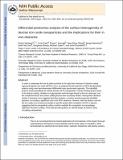| dc.contributor.author | Simberg, Dmitri | |
| dc.contributor.author | Park, Ji-Ho | |
| dc.contributor.author | Karmali, Priya P. | |
| dc.contributor.author | Zhang, Wan-Ming | |
| dc.contributor.author | Merkulov, Sergei | |
| dc.contributor.author | McCrae, Keith | |
| dc.contributor.author | Bhatia, Sangeeta N. | |
| dc.contributor.author | Sailor, Michael | |
| dc.contributor.author | Ruoslahti, Erkki | |
| dc.date.accessioned | 2012-12-10T15:01:11Z | |
| dc.date.available | 2012-12-10T15:01:11Z | |
| dc.date.issued | 2009-04 | |
| dc.date.submitted | 2009-01 | |
| dc.identifier.issn | 0142-9612 | |
| dc.identifier.issn | 1878-5905 | |
| dc.identifier.uri | http://hdl.handle.net/1721.1/75311 | |
| dc.description.abstract | In order to understand the role of plasma proteins in the rapid liver clearance of dextran-coated superparamagnetic iron oxide (SPIO) in vivo, we analyzed the full repertoire of SPIO-binding blood proteins using novel two-dimensional differential mass spectrometry approach. The identified proteins showed specificity for surface domains of the nanoparticles: mannan-binding lectins bound to the dextran coating, histidine-rich glycoprotein and kininogen bound to the iron oxide part, and the complement lectin and contact clotting factors were secondary binders. Nanoparticle clearance studies in knockout mice suggested that these proteins, as well as several previously identified opsonins, do not play a significant role in the SPIO clearance. However, both the dextran coat and the iron oxide core remained accessible to specific probes after incubation of SPIO in plasma, suggesting that the nanoparticle surface could be available for recognition by macrophages, regardless of protein coating. These data provide guidance to rational design of bioinert, long-circulating nanoparticles. | en_US |
| dc.description.sponsorship | National Cancer Institute (U.S.) (Grant CA119335) | en_US |
| dc.description.sponsorship | National Cancer Institute (U.S.) (Grant CA124427) | en_US |
| dc.language.iso | en_US | |
| dc.publisher | Elsevier | en_US |
| dc.relation.isversionof | http://dx.doi.org/10.1016/j.biomaterials.2009.03.056 | en_US |
| dc.rights | Creative Commons Attribution-Noncommercial-Share Alike 3.0 | en_US |
| dc.rights.uri | http://creativecommons.org/licenses/by-nc-sa/3.0/ | en_US |
| dc.source | PMC | en_US |
| dc.title | Differential proteomics analysis of the surface heterogeneity of dextran iron oxide nanoparticles and the implications for their in vivo clearance | en_US |
| dc.type | Article | en_US |
| dc.identifier.citation | Simberg, Dmitri et al. “Differential Proteomics Analysis of the Surface Heterogeneity of Dextran Iron Oxide Nanoparticles and the Implications for Their in Vivo Clearance.” Biomaterials 30.23-24 (2009): 3926–3933. | en_US |
| dc.contributor.department | Harvard University--MIT Division of Health Sciences and Technology | en_US |
| dc.contributor.mitauthor | Bhatia, Sangeeta N. | |
| dc.relation.journal | Biomaterials | en_US |
| dc.eprint.version | Author's final manuscript | en_US |
| dc.type.uri | http://purl.org/eprint/type/JournalArticle | en_US |
| eprint.status | http://purl.org/eprint/status/PeerReviewed | en_US |
| dspace.orderedauthors | Simberg, Dmitri; Park, Ji-Ho; Karmali, Priya P.; Zhang, Wan-Ming; Merkulov, Sergei; McCrae, Keith; Bhatia, Sangeeta N.; Sailor, Michael; Ruoslahti, Erkki | en |
| dc.identifier.orcid | https://orcid.org/0000-0002-1293-2097 | |
| mit.license | OPEN_ACCESS_POLICY | en_US |
| mit.metadata.status | Complete | |
